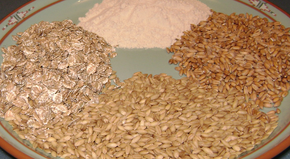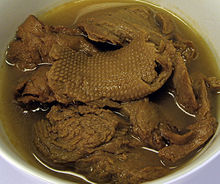Gluten
From Wikipedia, the free encyclopedia
| This article needs attention from an expert on the subject. The specific problem is: Sourcing of "adverse reactions" section requires expert attention. (October 2014) |
This article is about a protein found in certain grains. For a type of sticky rice (which does not contain any gluten), see Glutinous rice. For food products made from gluten, see Wheat gluten (food).
Gluten (from Latin gluten, "glue") is a protein composite found in wheat and related grains, including barley andrye. Gluten gives elasticity to dough, helping it rise and keep its shape and often gives the final product a chewytexture. Gluten is used in cosmetics, hair products, and other dermatological preparations.[1]
Gluten is the composite of a gliadin and a glutenin, which is conjoined with starch in the endosperm of variousgrass-related grains. The prolamin and glutelin from wheat (gliadin, which is alcohol-soluble, and glutenin, which is only soluble in dilute acids or alkalis) constitute about 80% of the protein contained in wheat fruit. Being insolublein water, they can be purified by washing away the associated starch. Worldwide, gluten is a source of protein, both in foods prepared directly from sources containing it, and as an additive to foods otherwise low in protein.
The fruit of most flowering plants have endosperms with stored protein to nourish embryonic plants duringgermination. True gluten, with gliadin and glutenin, is limited to certain members of the grass family. The stored proteins of maize and rice are sometimes called glutens, but their proteins differ from true gluten.
Contents
[hide]Extraction
Gluten is extracted from flour by kneading the flour, agglomerating the gluten into an elastic network, a dough, and then washing out the starch. Starch granulesdisperse in cold/low temperature water, and the dispersed starch will be sedimented and dried.[2] If a saline solution is used instead of water, a purer protein is obtained, with certain harmless impurities going into the solution with the starch. Where starch is the prime product, cold water is the favored solvent because the impurities stay with the gluten.
In home or restaurant cooking, a ball of wheat flour dough is kneaded under water until the starch disperses out. In industrial production, a slurry of wheat flour is kneaded vigorously by machinery until the gluten agglomerates into a mass. This mass is collected by centrifugation, then transported through several stages integrated in a continuous process.[3] Approximately 65% of the water in the wet gluten is removed by means of a screw press; the remainder is sprayed through anatomizer nozzle into a drying chamber, where it remains at an elevated temperature a short time to evaporate the water without denaturing the gluten. The process yields a flour-like powder with a 7% moisture content, which is air cooled and pneumatically transported to a receiving vessel. In the final step, the collected gluten issifted and milled to produce a uniform product.[4]
Uses[edit]
Bread products
Gluten forms when glutenin molecules cross-link to form a sub-microscopic network attached to gliadin, which contributesviscosity (thickness) and extensibility to the mix.[5] If this dough is leavened with yeast, fermentation produces carbon dioxidebubbles, which, trapped by the gluten network, cause the dough to rise. Baking coagulates the gluten, which, along with starch, stabilizes the shape of the final product. Gluten content has been implicated as a factor in the staling of bread, possibly because it binds water through hydration.[6]
The development of gluten (i.e., enhancing its elasticity) affects the texture of the baked goods. Gluten's attainable elasticity is proportional to its content of glutenins with low molecular weights as this portion contains the preponderance of the sulfur atoms responsible for the cross-linking in the network.[7][8] More refining (of the gluten) leads to chewier products such aspizza and bagels, while less refining yields tender baked goods such as pastry products.[9]
Generally, bread flours are high in gluten (hard wheat); pastry flours have a lower gluten content. Kneading promotes the formation of gluten strands and cross-links, creating baked products that are chewier in proportion to the length of kneading. An increased moisture content in the dough enhances gluten development,[9] and very wet doughs left to rise for a long time require no kneading (see no-knead bread). Shortening inhibits formation of cross-links and is used, along with diminished water and less kneading, when a tender and flaky product, such as a pie crust, is desired.
The strength and elasticity of gluten in flour is measured in the baking industry using a farinograph. This gives the baker a measurement of quality for different varieties of flours in developing recipes for various baked goods.[10][11]
Added gluten
Gluten, when dried and milled to a powder and added to ordinary flour dough, improves a dough's ability to rise and increases the bread's structural stability and chewiness.[12] Gluten-added dough must be worked vigorously to induce it to rise to its full capacity; an automatic bread machine or food processor may be required for kneading.[13] Generally, higher gluten levels are associated with higher amounts of overall protein.[14]
Imitation meats
For more details on the use of gluten in cooking, see Wheat gluten (food).
Gluten, especially wheat gluten, is often the basis for imitation meats resembling beef, chicken, duck (see mock duck), fish, and pork. When cooked in broth, gluten absorbs some of the surrounding liquid (including the taste) and becomes firm to the bite.[15][16]
Added to other foods
Gluten is often present in beer and soy sauce, and can be used as a stabilizing agent in more unexpected food products, such as ice cream and ketchup.[17][18] Foods of this kind raise a problem, because the hidden gluten constitutes a hazard for people with celiac disease.
Animal feed
Adverse reactions
Main articles: Gluten-sensitive enteropathy-associated conditions and Gluten-sensitive idiopathic neuropathies
In individuals with coeliac disease (spelled "celiac" in American English), consumption of gluten causes adverse health issues ranging from abdominal bloating, gas, diarrhea and vomiting to migraine headaches and joint pain. Coeliac disease is an autoimmune disorder that affects the digestive process of the small intestine. In 2009 research showed between 0.5 and 1.0 percent of people in the US and UK are sensitive to gluten due to coeliac disease.[20][21][22] It probably occurs with comparable frequency among all wheat-eating populations in the world.[23] Coeliac disease has no cure but is manageable with a gluten-free diet.
Non-coeliac gluten sensitivity (sometimes known as gluten intolerance) is a condition thought to arise as a result of an immunological response to gluten that differs in nature to the immune response characteristic of coeliac disease. However, there is no current scientific consensus that this is a genuine pathological condition and the mechanism by which this could occur is unknown. Frequently, symptoms could arise in individuals as a result of undiagnosed coeliac disease or due to a reaction to other components of wheat, such as FODMAPs.[24][25]
People can also experience adverse effects of wheat as result of a wheat allergy. As with most allergies, a wheat allergy causes the immune system to abnormally respond to a component of wheat that it treats as a threatening foreign body. This immune response is often time-limited and does not cause lasting harm to body tissues.[26] Wheat allergy and coeliac disease are different disorders.[27]
Labelling
International standards
The Codex Alimentarius international standards for food labelling has a standard relating to the labelling of products as "gluten-free". It only applies to foods that would normally contain gluten.[28]
Brazil
By law in Brazil, all food products must display labels clearly indicating whether or not they contain gluten.[29]
Canada
Labels for all food products sold in Canada must clearly identify the presence of gluten if it is present at a level greater than 10 ppm.[30]
United Kingdom
In the United Kingdom, only cereals must be labelled; labelling of other products is voluntary.[31]
United States
In the United States, gluten might not be listed on labels, because the US Food and Drug Administration (FDA) has historically classified gluten as GRAS ("generally recognized as safe"). In August 2013, FDA issued a final rule, effective August 2014, to define the term “gluten-free” for voluntary use in the labelling of foods i.e. "presence of gluten in the food must be less than 20 ppm."[32]



No comments:
Post a Comment